Related Research Articles

The Joker is a supervillain appearing in American comic books published by DC Comics. The character was created by Bill Finger, Bob Kane, and Jerry Robinson, and first appeared in the debut issue of the comic book Batman on April 25, 1940. Credit for the Joker's creation is disputed; Kane and Robinson claimed responsibility for the Joker's design while acknowledging Finger's writing contribution. Although the Joker was planned to be killed off during his initial appearance, he was spared by editorial intervention, allowing the character to endure as the archenemy of the superhero Batman.

Batman: The Animated Series is an American animated superhero television series based on the DC Comics superhero Batman. Developed by Bruce Timm and Eric Radomski, and produced by Warner Bros. Animation, it originally aired on Fox Kids from September 5, 1992, to September 15, 1995, with a total of 85 episodes.

Lt. James W. "Jim" Gordon Sr. is a fictional character appearing in American comic books published by DC Comics, most commonly in association with the superhero Batman. Created by Bill Finger and Bob Kane as an ally of Batman, the character debuted in the first panel of Detective Comics #27, Batman's first appearance, making him the first Batman supporting character ever to be introduced.
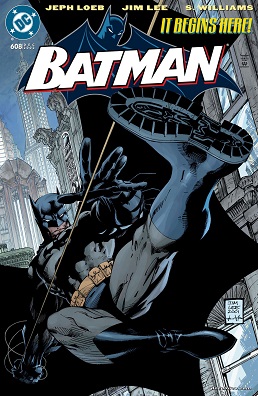
"Batman: Hush" is an American comic book story arc published by DC Comics featuring the superhero Batman. It was published in monthly installments within the comic book series Batman, running from issue #608–619 in October 2002 until September 2003. The story arc was written by Jeph Loeb, penciled by Jim Lee, inked by Scott Williams, and colored by Alex Sinclair, under the editorship of Bob Schreck.
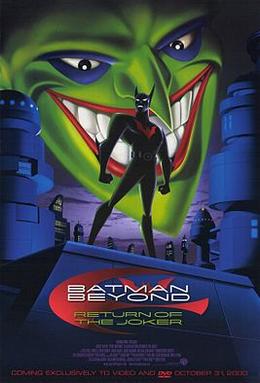
Batman Beyond: Return of the Joker is a 2000 American direct-to-video superhero film produced by Warner Bros. Animation and distributed by Warner Bros. Home Entertainment. It is the third film in the DC Animated Universe and is based on the animated series Batman Beyond while also serving as a continuation of and resolving plot points from The New Batman Adventures. The film features the DC Comics superheroes Batman and Terry McGinnis, as they try to unravel the mysterious return of the former's archenemy, the Joker, preparing a climatic showdown with the villain.
The Batman is an American animated television series based on the DC Comics superhero Batman. Developed by Michael Goguen and Duane Capizzi, and produced by Warner Bros. Animation, the series first aired on Kids' WB on September 11, 2004, then Cartoon Network on April 2, 2005. The show would become exclusive to the former network for its third, fourth, and fifth seasons in early 2006. The Batman won six Daytime Emmy Awards over the course of its run. Many elements from previous Batman storylines were borrowed and adapted, such as those from the comic books, film series and the animated shows like Batman: The Animated Series from the DC Animated Universe, but it remained strictly within its own distinct continuity. Jackie Chan Adventures artist Jeff Matsuda served as art director and provided the character designs. The production team altered the appearances of many of the comic books' supervillains for the show, such as the Joker, the Penguin, Mr. Freeze, and the Riddler.
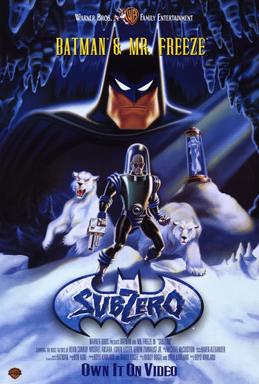
Batman & Mr. Freeze: SubZero is a 1998 direct-to-video animated superhero film, the second film based on Batman: The Animated Series, taking place between the end of the show and the start of The New Batman Adventures. Kevin Conroy and Michael Ansara reprise their respective roles from the series as the two title characters. It was produced by Warner Bros. Animation as a marketing tie-in with Batman & Robin and was animated overseas by Koko Enterprises and Dong Yang Animation in South Korea. The film won the Annie Award for Best Home Video Animation.

The Bat-Signal is a distress signal device appearing in American comic books published by DC Comics, as a means to summon the superhero, Batman. It is a specially modified searchlight with a stylized emblem of a bat affixed to the light, allowing it to project a large bat symbol onto cloudy night skies over Gotham City.

Harvey Bullock is a fictional detective appearing in American comic books published by DC Comics, commonly in association with the superhero Batman. The character first appeared in Detective Comics #441 and was created by Archie Goodwin and Howard Chaykin. In animation, he appeared throughout the DC Animated Universe, voiced by Robert Costanzo. He debuted in live-action in 2014 on Fox's television series Gotham, portrayed by Donal Logue.

Firefly is a supervillain appearing in American comic books published by DC Comics. Created by France Herron and Dick Sprang, he made his debut in Detective Comics #184. Initially portrayed as a criminal who utilized lighting effects to commit robberies, Firefly was later reimagined as a sociopathic pyromaniac with an obsessive compulsion to start fires following Crisis on Infinite Earths' reboot of the DC Universe in the 1980s. This darker depiction of the character has since endured as one of the superhero Batman's most recurring enemies and belongs to the collective of adversaries that make up his central rogues gallery.
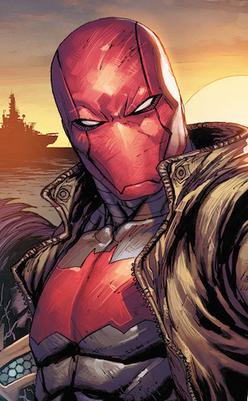
The Red Hood is an alias used by multiple characters appearing in American comic books published by DC Comics. The identity was first used in the 1951 story line "The Man Behind the Red Hood!", which provides the earliest origin story for the Joker. The storyline depicts an unnamed criminal wearing a red dome-shaped hood who, after a chance encounter with Batman, is disfigured by chemicals and becomes insane, giving birth to his future Joker persona.

The DC Comics character Batman has been adapted into various media including film, radio, television, and video games, as well as numerous merchandising items. The Batman franchise has become one of the highest-grossing media franchises of all time.

Thomas Alan Wayne, M.D. is a fictional character appearing in American comic books published by DC Comics. He is the father of Bruce Wayne (Batman), and husband of Martha Wayne as well as the paternal grandfather of Damian Wayne. Wayne was introduced in Detective Comics #33, the first exposition of Batman's origin story. A gifted surgeon and philanthropist to Gotham City, Wayne inherited the Wayne family fortune after Patrick Wayne. When Wayne and his wife are murdered in a street mugging, Bruce is inspired to fight crime in Gotham as the vigilante Batman.

"Heart of Ice" is the fourteenth episode of the first season of American animated television series Batman: The Animated Series, first aired on September 7, 1992, written by Paul Dini, and directed by Bruce Timm. This episode features the first appearance in the series of Mr. Freeze. In the comics, Freeze first appeared in Batman #121 in February 1959, with this episode providing a complete overhaul of his character, going from laughing stock to tragic villain. The episode also introduces Freeze's wife Nora Fries and his motivation to find a cure for her terminal illness, both of which were later carried over to the comic books. The episode begins a four-episode and one film story arc for Freeze that continues in "Deep Freeze", the feature film Batman & Mr. Freeze: SubZero, The New Batman Adventures episode "Cold Comfort" and is concluded in the Batman Beyond episode "Meltdown".

In addition to DC Comics books, the superhero Robin also appears in other media, such as films, television and radio. Dick Grayson, Jason Todd, Tim Drake, Stephanie Brown, and Damian Wayne are examples of the characters who use the name Robin.
Originally created in 1967, the fictional comic book character Barbara Gordon has been adapted into various other forms of media. The character has appeared in both live action and animated television series and films, as well as in video games in her alter-egos as both Batgirl and Oracle!.

The Joker, a supervillain in DC Comics and archenemy of the superhero Batman, has appeared in various media. WorldCat records over 250 productions featuring the Joker as a subject, including films, television series, books, and video games. Live-action films featuring the character are typically the most successful.

The character Two-Face was created by Bob Kane and first appeared in Detective Comics #66. However, he did not appear outside comics until half a century later in Batman: The Animated Series. Two-Face has since been substantially adapted from the comics into various forms of media, such as feature films, television series and video games. Two-Face has been voiced by Richard Moll in the DC Animated Universe, Troy Baker in the Batman: Arkham series, Billy Dee Williams in The Lego Batman Movie, and William Shatner in Batman vs. Two-Face. His live-action portrayals include Billy Dee Williams in Batman (1989), Tommy Lee Jones in Batman Forever, Aaron Eckhart in The Dark Knight, and Nicholas D'Agosto in the television series Gotham. In 2009, Two-Face was ranked #12 on IGN's list of the Top 100 Comic Book Villains of All Time.
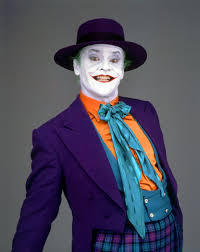
Jack Napier, also known as the Joker, is a fictional character introduced in the 1989 superhero film Batman, directed by Tim Burton. Primarily portrayed by Jack Nicholson, the character was based on the DC Comics supervillain the Joker. His name is a play on the word Jackanapes, as well as a reference to the names Jack Nicholson and Alan Napier, the latter having portrayed Alfred Pennyworth in the 1960s Batman TV series and having died the previous year. This depiction is notable for being one of the first adaptations of the character to have a distinct first and last name, as well as one of the few instances which show his origins. This iteration of the Joker is a psychopathic gangster who serves as the right-hand man of Gotham City crime boss Carl Grissom until he is disfigured following a confrontation with the vigilante Batman; his disfigurement drives him insane, and he becomes a costumed criminal obsessed with "out-doing" the Dark Knight, who he believes is getting too much press.

Batman: Death in the Family is a 2020 American animated interactive short film that explores alternate outcomes of the 1988 comics storyline of the same name, in which Jason Todd, the second character to bear the mantle of Batman's sidekick Robin, was murdered by the Joker. It is a spiritual sequel to Batman: Under the Red Hood, and was released on Blu-ray on October 13, 2020.
References
- ↑ "Actors who were almost cast as the Joker". 23 September 2016.
- ↑ Lis, Martin (September 2, 2017). "Exclusive: Tim Curry Reveals Why Mark Hamill Replaced Him as JOKER". ScreenGeek. Retrieved September 6, 2017.
- ↑ [Batman: The Animated Series: The Legacy Continues, Voices of the Knight, Arkham's Files The Joker]
- ↑ Burton, Byron and Couch, Aaron (September 5, 2017). "'Batman' at 25: Hirings, Firings and Other Last-Minute Changes Behind the Animated Classic". The Hollywood Reporter. Retrieved July 17, 2018.
{{cite magazine}}: CS1 maint: multiple names: authors list (link) - ↑ [Batman: The Animated Series: The Legacy Continues, Voices of the Knight, Arkham's Files The Joker]
- ↑ "Batman: The Animated Series: "Christmas with the Joker"". The A.V. Club . 6 December 2010.